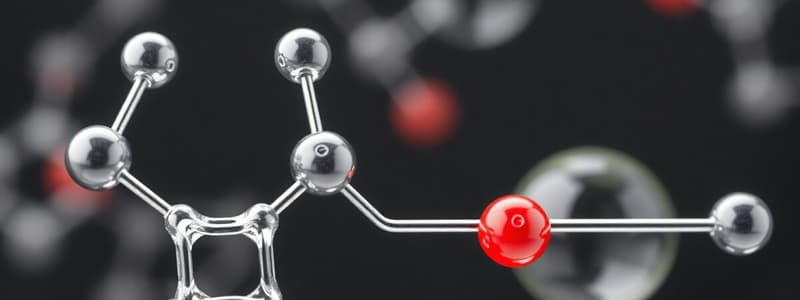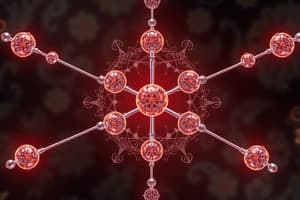Podcast
Questions and Answers
What is a significant characteristic of covalent bonds?
What is a significant characteristic of covalent bonds?
- They occur only in inorganic compounds.
- They involve sharing electrons between atoms. (correct)
- They are weaker than hydrogen bonds.
- They involve the transfer of electrons between atoms.
Which type of bond is primarily responsible for the properties of water?
Which type of bond is primarily responsible for the properties of water?
- Covalent bonds
- Metallic bonds
- Ionic bonds
- Hydrogen bonds (correct)
What role do isomers play in organic chemistry?
What role do isomers play in organic chemistry?
- Isomers are compounds with identical molecular formulas but different structures. (correct)
- Isomers have the same physical properties regardless of structure.
- Isomers can exist in only one type of molecule.
- Isomers are only present in inorganic compounds.
What is an essential requirement for cell communication in multicellular organisms?
What is an essential requirement for cell communication in multicellular organisms?
Which fundamental concept is necessary to understand the properties of compounds?
Which fundamental concept is necessary to understand the properties of compounds?
What happens to a hydrogen atom during the formation of a hydronium ion (H3O+)?
What happens to a hydrogen atom during the formation of a hydronium ion (H3O+)?
Which statement best describes the effect of acids on a solution?
Which statement best describes the effect of acids on a solution?
At 25ºC, what is the relationship between the concentrations of H+ and OH– in pure water?
At 25ºC, what is the relationship between the concentrations of H+ and OH– in pure water?
How does the pH scale relate to H+ ion concentration?
How does the pH scale relate to H+ ion concentration?
What is a characteristic of a basic solution?
What is a characteristic of a basic solution?
What is the primary characteristic of ionic bonds?
What is the primary characteristic of ionic bonds?
What is a characteristic of ionic compounds when dissolved in water?
What is a characteristic of ionic compounds when dissolved in water?
What is the term for molecules that have an affinity for water?
What is the term for molecules that have an affinity for water?
Which of the following best describes a hydrogen bond?
Which of the following best describes a hydrogen bond?
What happens to oil when mixed with water?
What happens to oil when mixed with water?
Which statement about water as a solvent is true?
Which statement about water as a solvent is true?
Which ion is positively charged?
Which ion is positively charged?
What creates a hydration shell around ions in an aqueous solution?
What creates a hydration shell around ions in an aqueous solution?
What happens between atoms with incomplete valence shells?
What happens between atoms with incomplete valence shells?
Which type of bond involves the sharing of three pairs of valence electrons?
Which type of bond involves the sharing of three pairs of valence electrons?
What distinguishes polar covalent bonds from nonpolar covalent bonds?
What distinguishes polar covalent bonds from nonpolar covalent bonds?
Which of the following represents a double bond in a structural formula?
Which of the following represents a double bond in a structural formula?
Which of these is a characteristic of ionic bonds?
Which of these is a characteristic of ionic bonds?
Which interaction is considered the weakest among the types of chemical bonds?
Which interaction is considered the weakest among the types of chemical bonds?
What is the definition of electronegativity in a chemical bond?
What is the definition of electronegativity in a chemical bond?
When polar covalent bonds are formed, what does it result in?
When polar covalent bonds are formed, what does it result in?
Which molecule is correctly represented as having a single covalent bond?
Which molecule is correctly represented as having a single covalent bond?
What is the main characteristic of Van der Waals interactions?
What is the main characteristic of Van der Waals interactions?
What is an element?
What is an element?
Which of the following elements make up 96% of living matter?
Which of the following elements make up 96% of living matter?
What makes up the atomic nucleus?
What makes up the atomic nucleus?
What determines an atom's chemical behavior?
What determines an atom's chemical behavior?
What does the atomic number represent?
What does the atomic number represent?
What is the maximum number of electrons that can occupy the first electron shell?
What is the maximum number of electrons that can occupy the first electron shell?
Atoms with a full valence shell are considered to be:
Atoms with a full valence shell are considered to be:
What determines an atom's valence?
What determines an atom's valence?
Which statement about the periodic table is true?
Which statement about the periodic table is true?
The mass number of an atom is defined as:
The mass number of an atom is defined as:
What defines structural isomers?
What defines structural isomers?
What is true about cis-trans isomers?
What is true about cis-trans isomers?
What happens to a molecular structure with multiple C=C double bonds?
What happens to a molecular structure with multiple C=C double bonds?
What characterizes a chiral carbon?
What characterizes a chiral carbon?
Why are stereoisomers important in biology?
Why are stereoisomers important in biology?
How do enantiomers differ?
How do enantiomers differ?
What does having one chiral carbon allow in molecular structure?
What does having one chiral carbon allow in molecular structure?
Which of the following is an example of geometric isomerism?
Which of the following is an example of geometric isomerism?
Flashcards
Valence
Valence
The number of electrons an atom can gain, lose, or share to achieve a full outer shell.
Covalent bond
Covalent bond
A chemical bond formed by the sharing of electrons between two atoms.
Noncovalent bonds
Noncovalent bonds
Weak chemical bonds that involve the attraction between partially positive and partially negative atoms.
Hydrogen bond
Hydrogen bond
Signup and view all the flashcards
Organic chemistry
Organic chemistry
Signup and view all the flashcards
What is an element?
What is an element?
Signup and view all the flashcards
What is a compound?
What is a compound?
Signup and view all the flashcards
What are essential elements?
What are essential elements?
Signup and view all the flashcards
Which elements make up the most of living matter?
Which elements make up the most of living matter?
Signup and view all the flashcards
What are trace elements?
What are trace elements?
Signup and view all the flashcards
What is an atom?
What is an atom?
Signup and view all the flashcards
What is the atomic nucleus?
What is the atomic nucleus?
Signup and view all the flashcards
Where are electrons found in an atom?
Where are electrons found in an atom?
Signup and view all the flashcards
What is the valence shell?
What is the valence shell?
Signup and view all the flashcards
What are valence electrons?
What are valence electrons?
Signup and view all the flashcards
Reactants
Reactants
Signup and view all the flashcards
Products
Products
Signup and view all the flashcards
Ionic Bonds
Ionic Bonds
Signup and view all the flashcards
Van der Waals interactions
Van der Waals interactions
Signup and view all the flashcards
Electronegativity
Electronegativity
Signup and view all the flashcards
Nonpolar covalent bond
Nonpolar covalent bond
Signup and view all the flashcards
Polar covalent bond
Polar covalent bond
Signup and view all the flashcards
What are ions?
What are ions?
Signup and view all the flashcards
What is a cation?
What is a cation?
Signup and view all the flashcards
How does an ionic bond form?
How does an ionic bond form?
Signup and view all the flashcards
What is an ionic compound?
What is an ionic compound?
Signup and view all the flashcards
What is a solution?
What is a solution?
Signup and view all the flashcards
What is an aqueous solution?
What is an aqueous solution?
Signup and view all the flashcards
How can water dissolve nonionic polar molecules?
How can water dissolve nonionic polar molecules?
Signup and view all the flashcards
Why is water's ability to form hydrogen bonds crucial for biological processes?
Why is water's ability to form hydrogen bonds crucial for biological processes?
Signup and view all the flashcards
What is a base?
What is a base?
Signup and view all the flashcards
What is the pH scale?
What is the pH scale?
Signup and view all the flashcards
What is dynamic equilibrium in water?
What is dynamic equilibrium in water?
Signup and view all the flashcards
Structural Isomers
Structural Isomers
Signup and view all the flashcards
Geometric Isomers
Geometric Isomers
Signup and view all the flashcards
Chiral Carbon
Chiral Carbon
Signup and view all the flashcards
Enantiomers
Enantiomers
Signup and view all the flashcards
Cis Isomer
Cis Isomer
Signup and view all the flashcards
Trans Isomer
Trans Isomer
Signup and view all the flashcards
Tetrahedral Carbon
Tetrahedral Carbon
Signup and view all the flashcards
Stereoisomers
Stereoisomers
Signup and view all the flashcards
Study Notes
Molecules of Life 1
- Textbook chapters cover topics 2-4
- Focuses on the chemistry of life
- Includes valence, covalent bonds, noncovalent bonds (hydrogen bonds), basic organic chemistry, molecular shape, and isomers.
- Review of atoms, ions, protons, electrons, neutrons, elements, and compounds is assumed but will be reviewed.
Chemical Composition of a Human Being
- Human beings are primarily composed of oxygen (65%), followed by carbon (18.5%), hydrogen (9.5%), and nitrogen (3.3%) by weight.
- The relative abundance of elements in the Earth's crust is different from that in living organisms.
- Exam questions will not focus on the percentage of elements in the human body or Earth's crust.
Development from a Single Cell
- All humans develop from a single cell.
- The human body is comprised of trillions of cells with varied functions
- PoB1 will detail how simple building blocks make cells, how these cells communicate, and how they cooperate to form organs and organisms.
Chemistry Knowledge Assumed
- Understanding of atoms, ions, protons, electrons, and neutrons is presumed.
- Knowledge of elements and compounds is assumed.
Determining Compound Properties
- A compound's properties depend on the arrangement of atoms (structure) and how atoms are bonded.
- The number of protons determines an atom's identity.
- Electron distribution plays a key role in forming bonds.
Elements and Compounds
- Matter is composed of elements.
- An element cannot be broken down into simpler substances by chemical reactions.
- A compound is a substance formed from two or more elements in a fixed ratio.
- Compound properties differ from its constituent elements.
The Elements of Life
- 92 natural elements exist, but only 20-25 are essential for life in humans.
- Oxygen, hydrogen, carbon, and nitrogen make up about 96.3% of living matter.
- Calcium, phosphorus, potassium, and sulfur make up the remainder of the crucial 4%.
- Trace elements are also necessary but in minute quantities.
Properties of Elements
- Each element is composed of unique atoms.
- An atom is the smallest unit of matter retaining element properties.
- Atoms are composed of subatomic particles—neutrons (neutral), protons (positive), and electrons (negative).
- The nucleus contains protons and neutrons; electrons orbit the nucleus.
Electron Distribution and Chemical Properties
- Electrons reside in electron shells with varying energy levels.
- An atom's chemical behavior depends on electron shell distribution.
- The periodic table organizes elements by electron distribution.
Properties of Elements
- Mass number (A): Represents the sum of protons and neutrons.
- Atomic number (Z): Is equal to the number of protons in an atom’s nucleus.
Periodic Table
- Displays known elements ordered by increasing atomic number.
- Elements in each row exhibit electron addition patterns.
Valence
- Valence electrons are outermost shell electrons.
- Atomic chemical behavior is predominantly determined by valence electron numbers.
- Atoms with full valence shells are chemically inert.
Goal of Valence Shells
- Atoms interact to complete their valence shells.
- First shell holds a maximum of 2 electrons.
- Second and third shells hold a maximum of 8 and 18 electrons, respectively.
Poll Question
- Atoms containing 8 electrons in their outer shell tend to be stable.
Chemical Reactions
- Chemical reactions involve the making and breaking of chemical bonds.
- Reactants are initial molecules.
- Products are resultant molecules.
Chemical Bonding
- Atoms form bonds with incomplete valence shells to attain stability.
- Covalent bonding involves electron sharing.
- Ionic bonding involves electron transfer.
- Hydrogen bonding results from attractions between polar molecules.
Types of Chemical Bonds
- Covalent bonds, Ionic bonds, Hydrogen bonds, Van der Waals attractions
Covalent Bonds
- Covalent bonds link atoms within molecules; they can form among the same or different elements.
- Bonds must add up to an atom's valence.
- A single bond shares one electron pair, a double bond shares two, and a triple bond shares three.
Notation
- Molecular formula represents a molecule's composition.
- Condensed formula is a concise representation, often omitting hydrogen details.
- Structural formulas show atom connections and bonding locations.
- Line diagrams or skeletal formulas offer a simplified illustration method, often used for complex molecules.
Electronegativity
- Atoms in a molecule differently attract electrons (electronegativity).
- Electronegativity is the tendency of an atom to pull shared electrons closer..
- Higher electronegativity means more electron pulling power
Types of Covalent Bonds
- Nonpolar covalent bonds feature equal electron sharing.
- Polar covalent bonds feature unequal electron sharing. The more electronegative atom results in a partial negative (δ⁻) charge; the less electronegative atom has a partial positive (δ⁺) charge.
Polar Covalent Bonds
- Electrons in polar covalent bonds predominantly reside near the more electronegative atom.
Nonpolar Covalent Bonds
- Nonpolar covalent bonds are exemplified by atoms such as Hydrogen (H₂), Chlorine (Cl₂), Oxygen (O₂), and Nitrogen (N₂).
Ionic Bonds
- Ionic bonds involve electron transfer between atoms.
- Positively charged ions are cations; negatively charged ions are anions.
- Attraction between anions and cations forms ionic bonds.
Ionic Bonds
- Ionic compounds are formed when ionic bonds form.
- Salts such as sodium chloride (table salt) are often found as crystals.
- Salting is a common example of ionic bonding, occurring naturally as crystal lattices.
- Ionic compounds are stable in dry conditions but readily dissociate in water.
Hydrogen Bonds
- Hydrogen bonds form when a hydrogen atom already covalently linked to one electronegative atom is attracted to another electronegative partner.
- Common in living cells, mostly with oxygen or nitrogen.
- Water's polarity enables hydrogen bonding among its molecules.
Water as a Solvent
- Water dissolves many substances because of its polarity.
- A solution is a homogeneous mixture of substances wherein a solvent dissolves solutes to form a solution, making water the most important solvent for life.
- When an ionic compound dissolves in water, each ion becomes surrounded by water molecules, forming a hydration shell.
- Water can dissolve compounds formed from non-ionic polar molecules as well. Polar molecules can have regions containing ionic and polar regions that easily dissolve in water
Water (Hydrophilic and Hydrophobic Substances)
- Hydrophilic substances are water-attracting; hydrophobic substances repel water.
Nonpolar Molecules and Water
- Oil and similar nonpolar molecules are hydrophobic and cluster in water, minimizing the water-oil area of contact.
Acidic and Basic Conditions
- Water molecules dissociate and reform in dynamic equilibrium, with equivalent H⁺ and OH⁻ concentrations.
- Acids increase H⁺ concentration; bases reduce H⁺ concentration.
pH Scale
- pH measures H⁺ concentration in a solution.
- Acidic solutions have a pH less than 7; neutral solutions have a pH of 7; basic solutions have a pH greater than 7.
Van der Waals Interactions
- Unbalanced electron distribution creates temporary partial charges, leading to weak attractions among molecules which are close together
Molecular Shape and Function
- A molecule's size and shape influence its function.
- Atomic orbital positions determine molecular shapes.
- Hybridization of atomic orbitals shapes molecules.
Carbon as a Foundation
- Carbon forms the essential backbone of biological molecules.
- Carbon's ability to form four bonds is fundamental for its roles in molecules.
Organic Chemistry Properties
- Carbon has a valence of 4.
- Carbon bonds to four other atoms, creating complex structures.
- Examples of carbon compounds include methane (CH₄), ethane (C₂H₆), and ethene (ethylene, C₂H₄).
Drawing Organic Structures
- Chemists often implicity represent carbon and hydrogen connections in complex organic molecules, using corners for carbon and typically omitting hydrogens except in simple examples
Isomers
- Isomers are molecules with the same molecular formula but different structures and properties.
- Structural isomers differ in bond connectivity.
- Geometric isomers, also known as cis-trans isomers, differ in spatial arrangements around double bonds.
Structural Isomers
- Molecules share the same molecular formula but have different atomic connections
Geometric Isomers
- Geometric isomers have identical atom connections but differ in spatial arrangements around double bonds, which cannot rotate.
Geometric Isomers
- Multiple C=C double bonds can lead to complex structural variations in large molecules.
Tetrahedral Structure
- Carbon atoms with four single bonds have a tetrahedral shape.
Chiral Carbons and Stereoisomers
- Chiral carbon atoms are asymmetric.
- Chiral carbon atoms are bonded to four different functional groups.
- Stereoisomers (mirror image molecules) cannot be superimposed and have different properties.
Why Care About Stereoisomers?
- Many biological molecules contain chiral carbons.
- Biological systems are highly sensitive to molecular shape differences (as with stereoisomers).
- For instance, different isomers of the same molecule have vastly different properties, e.g., carvone (smells like spearmint or caraway) or ibuprofen (painkiller).
Studying That Suits You
Use AI to generate personalized quizzes and flashcards to suit your learning preferences.




